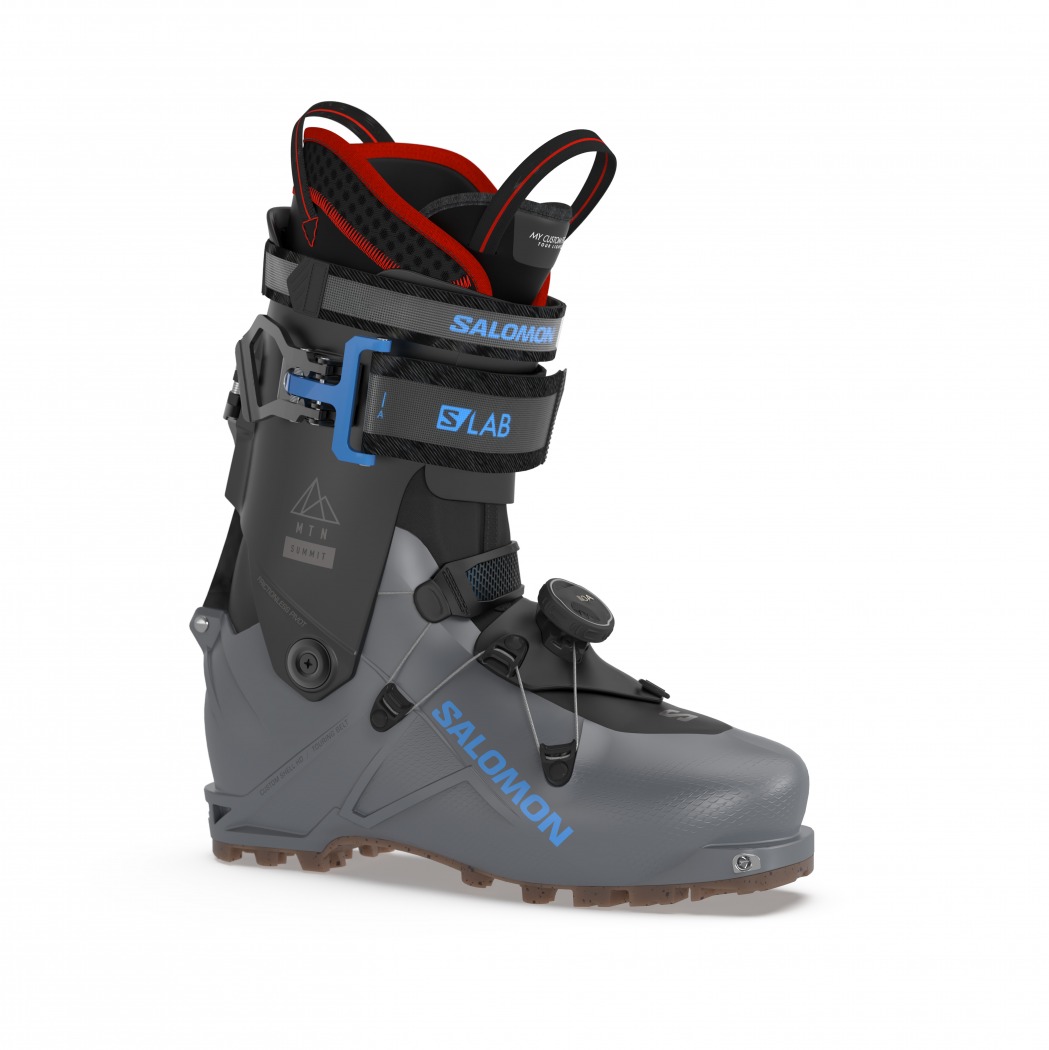
Salomon’s S/LAB MTN Summit Pro ski boot available 2022-2023.
There are a few directions to go with a gear review. Allow the brain first to pitter-patter down the path of tech specs, or one might diverge and get wishy-washy and aim to appeal to one’s emotional sensibilities, saying things like, “nirvana was (or wasn’t) achieved when slarving this or that.” I’m acknowledging a few things upfront; there’s some subjectivity in reviews when deviating the discussion from strict spec standards. This is a boot review, and as you’ll likely do, please boot fit at a shop to ensure that what I’m about to say about the boot, aligns with what you’re looking for in a boot.
So, here we are to meditate on Salomon’s 2022-2023 S/LAB MTN Summit. This boot is at the sharp end material and cost-wise for the French brand’s revamped MTN boot series.
In total, the new line encompasses five boots, ranging from the S/LAB MTN Summit (MSRP: $799) and onward. The remaining four boots are the MTN Summit Pro (MSRP: $699), MTN Summit Pro W (MSRP: $699)m, MTN Summit Pure (MSRP: $599), and MTN Summit Pure W (MSRP: $599). Although tags like “Pro” and “Pure” are aspirational for some, I’m focusing on the straight-up S/LAB MTN Summit, which, although lacking those tags, sits atop the MTN price, stiffness, and lightness pyramid.
The S/LAB MTN Summit helps Salomon enter the ethereal realm of stiffish, yet big-vert, tourable 1kg boots. The weigh-in for our size 27.5 liners (with stock insoles) found 236g and 234g, with the shells weighing 970g and 974g, respectively. The 27.5 S/LAB MTN (BSL 298 mm) Summit is approximately a 1206g boot (27.5) with a 99mm last (27.5). For me, that’s in the 1kg+ discussion.
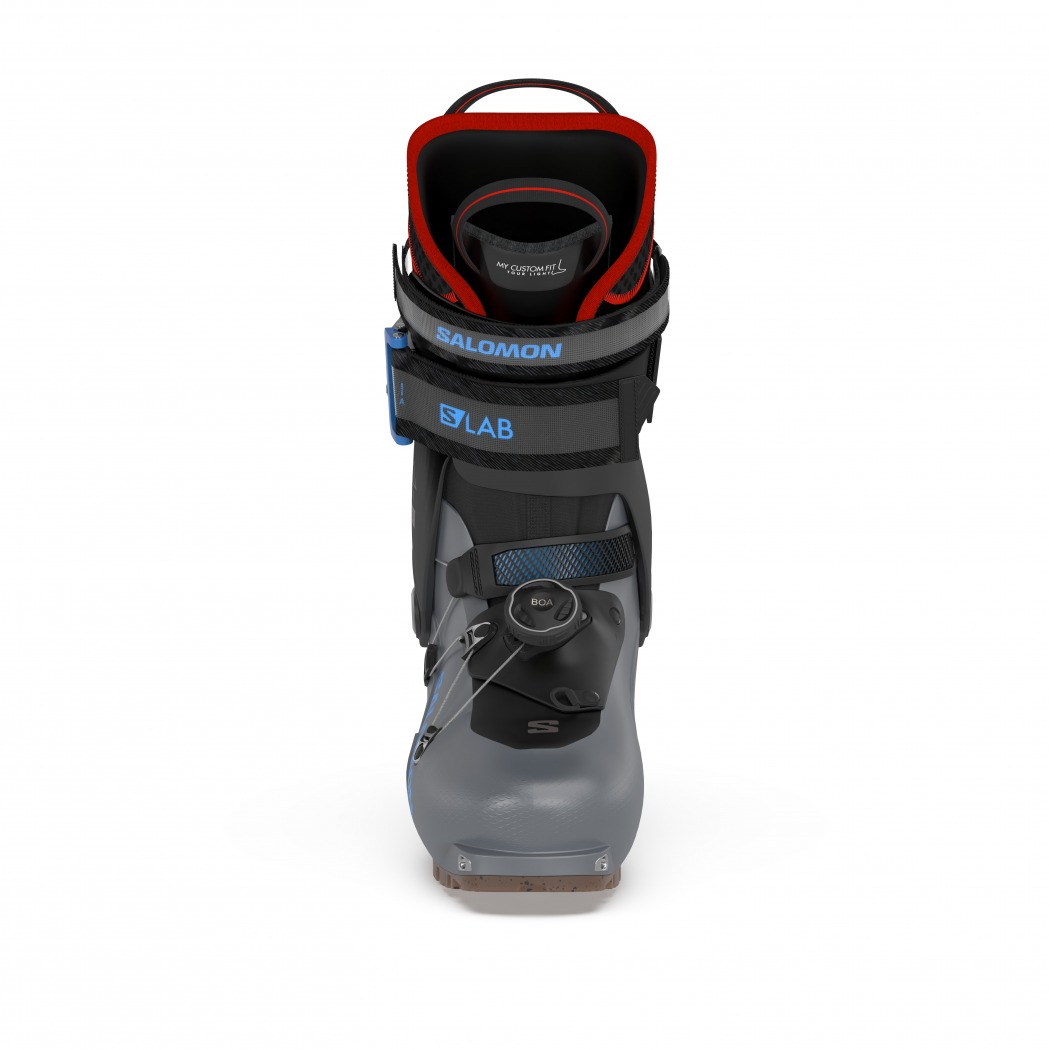
The 2022/2023 S/Lab MTN Summit comes in at approx. 2006g for a stiff-flexing light-on-your-feet touring option.
The Fit:
Enough hard data for the moment; let’s get subjective with boot fit. The boot-sole rubber meets the road with the fit. For a few years, as I torqued my feet in some old BD Quadrants and Dynafit TLT 6s, I considered my feet tough to fit into the “normal” parameters of an AT ski boot. On a whim, I mail-ordered a Fischer Travers Carbon in a 27.5. It was love at first BOA cinch. It turns out that as boot manufacturers have diversified their last widths, insole heights, and toe box shapes, more of us are finding proper fitting boots almost out of the box without heating, gluing, and punching. I now consider myself lucky; I easily fit into several boots with minimal mods.
I sit in that 100mm last sweet spot. My heel is not too wide or narrow. I need an average instep height for a boot to be comfy. My calves are skinny, though, so I often eat up cuff volume with a spoiler. I don’t like my toes too confined—is there a word for toe-claustrophobia? If so, I have it.
I feel for those needing excessive boot-moding to nail a fit, but I can’t necessarily empathize. I’m smiling as I type this: the S/LAB MTN Summit is a master-fit on my foot. The heat-moldable liner snugs my heel with firm foam, and sculpted foam ridges reinforce that hold. And as I noted in a prior boot dissection, I like to take boot adjustments incrementally, changing one piece at a time to zero in on how it impacts the fit, touring, and skiing. I’ve been in this boot a month. There’s been no heat molding and no plan to bake the liners, I’m still loving the stock liner and stock footbed. I did insert the included 1mm volume reducer; it’s placed under the footbed.
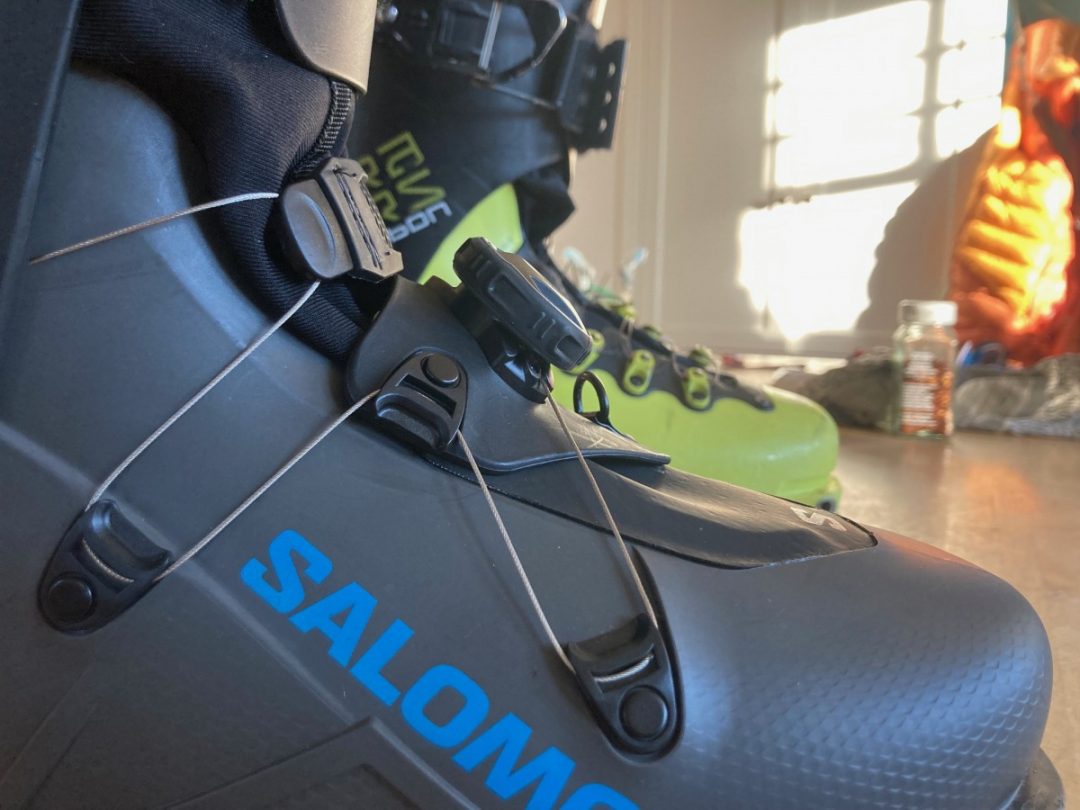
A close up of the S/Lab MTN Summit’s six-point BOA Closure system.
The stock fit is further customized with a six-point BOA system on the lower boot. The lower is constructed of heat-moldable Grillamid +. Salomon’s take on the BOA closure is different from what I am most familiar with, the Travers’ system. The Fischer’s BOA lacing runs lower on the forefoot than the S/Lab MTN Summit‘s BOA closure. (See photo.) And the BOA adjustment knob sits to the side of the forefoot on the Fischers; it is centered on the S/Lab MTN Summits.
Incorporated into the Salomon BOA system is a “touring belt” that wraps the ankle region with an approximately one-inch wide band of soft rubber. Tighten up the BOA, and the “touring belt” holds the ankle firm, but comfortably, and the heel feels locked in place. Does the system pull your heel into the heel pocket and keep it there? That’s a “yes” for this writer. With the BOA cinched for touring, or even tighter for descending, you can customize the fit for skiing uphill or charging. But more on that later.
The upper boot, constructed from Pebax plastic, is secured with a 45mm velcro cuff strap and an additional 25mm power strap to top it off. A carbon/plastic spine runs up the back of the shell. With all the closure systems tensioned, and the boot locked out, the fit is snug, precise, and confidence-inspiring.
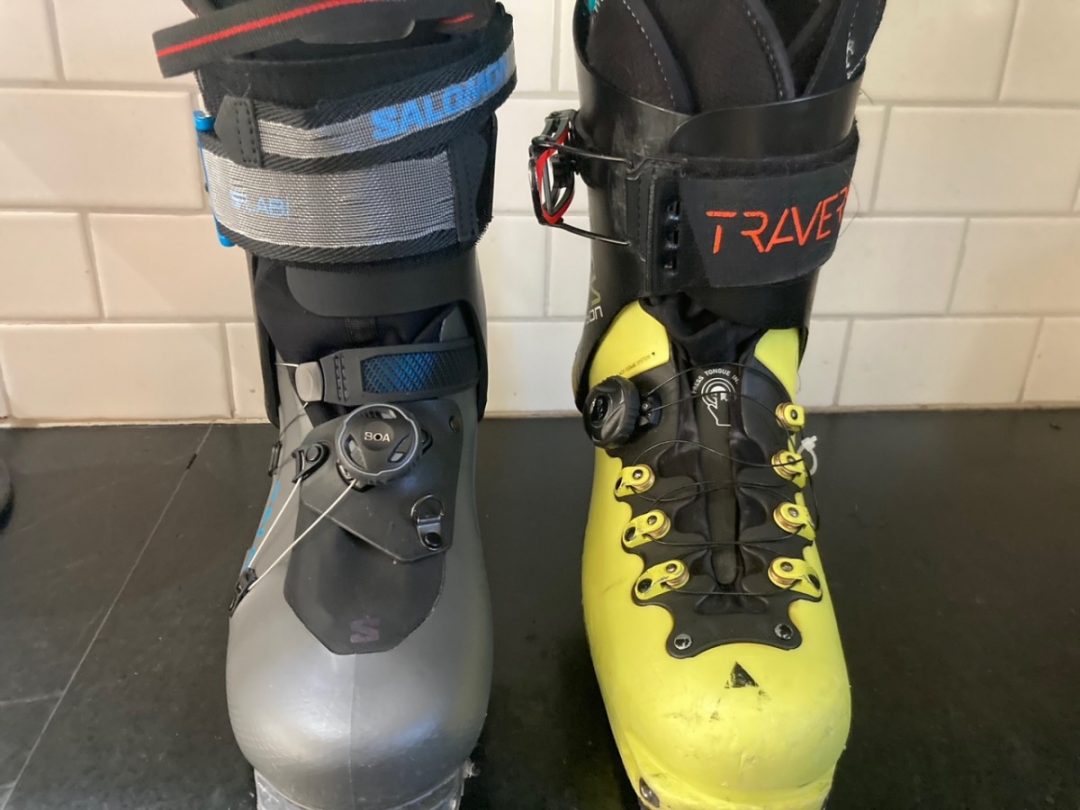
A side by side comparison of the S/Lab MTN Summit and Travers Carbon. Lots to see here for comparison. The shell width of the S/Lab MTN Summit is a bit wider than the Travers in the forefoot.
One aspect about the boot’s shape that’s been bantered about is the forefoot’s width—with some saying it is almost too wide. I would describe the forefoot area in the S/Lab MTN Summit like some distance running shoes, primarily Altras. From my experience, Altras have a wider than average toe box/forefoot, allowing one’s toes to splay out during the impact phase of the running stride. (I like the toebox feel of Altras when walking or running, but I can do without the zero heel drop.) The S/Lab MTN Summit forefoot does seem wider, by like 1.5mm, than the boot’s midfoot. So far, this has been an asset. My forefoot has enough room to swell throughout a day of touring, and absorb the slight impact of the forward skinning motion. My toes and forefoot are not moving around in a blister-causing fashion. There seems to be enough spatial “breathing” room for the toes to splay naturally. To reiterate, I would not say the forefoot is too roomy. But, again, if you’re concerned about that, try them on before dropping the coin.
Touring:
I imagine this highly engineered ski-slipper would attract a skier desiring a 1kg realm boot, with a comfy range of motion for long slogging. I’ve made a point to schedule some slogs into the program since before this latest storm cycle, the turns here were marginal and the touring better.
The Travers Carbon, from my experience, sets a high bar for tourability. Salomon claims 75 degrees range of motion for the S/Lab MTN Summit. The Travers Carbon claims 80 degrees. In terms of ROM, if the Travers’ verified massive ROM is not a ground-truthed best-in-class, then I’ve been fooled: it’s a seemingly friction-free tourer. But to dispel any bias, I spent several days touring in one Travers and one S/Lab MTN Summit. The dual-brand touring was, at times, an experience where I closed my eyes, skinning along, trying to discern the differences.
Side by side, the Travers is a better tourer. The ROM is slightly greater, and the touring fit is just that much more efficient. Yet, the difference was not glaring in the sense that I would never take the S/Lab MTN Summits on a multi-day high traverse. Here’s the thing: when wearing both S/Lab MTN Summits (the Travers were left to sulk at home), what is apparent is that the tourability is excellent, just not best in class, if you have the Travers or something similar as an option for comparison.
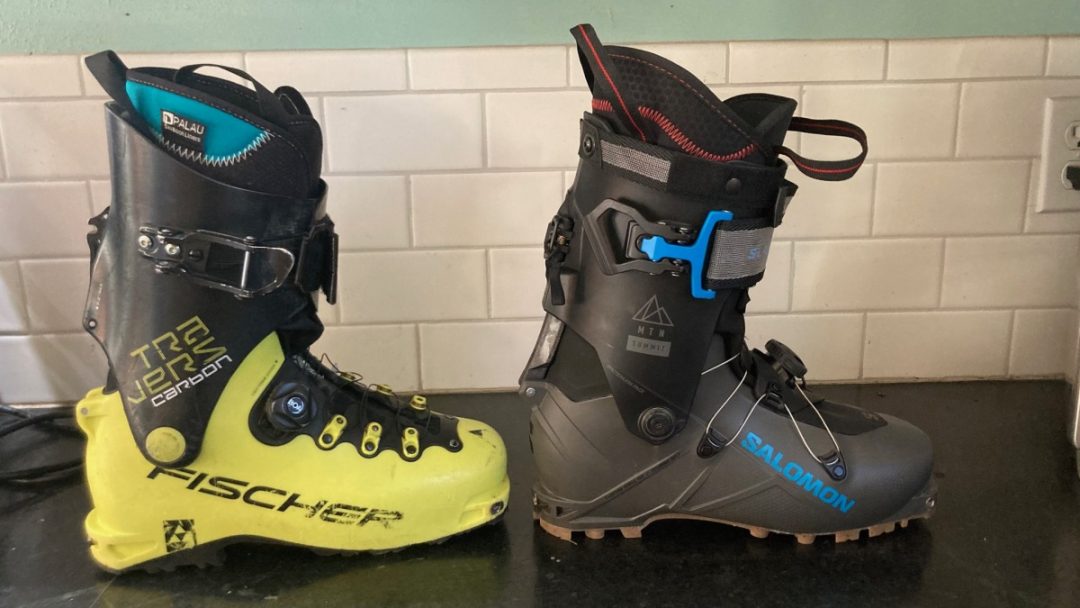
Side by side, while skiing, the Fischer gets the nod for ROM. But the S/Lab MTN Summit shines too, just not as bright.
Like with the Travers, it takes a smidge of time wearing the S/Lab MTN Summits to tension the BOA perfectly and cinch the upper cuff loose enough that I’m comfy, minimizing resistance when touring. I think the S/Lab MTN Summit’s perceived marginally lower score on tourability is due to the “touring belt.” Again, overall, the belt concept is a total asset, but I think even when snugged accordingly for skinning, the belt decreases the ROM ever so slightly. The Travers, by comparison, are seemingly unrestricted, considering ankle mobility when touring.
That all said, it’s an easy lickety-split fast swap from tour mode to ski mode and back again in the S/Lab MTN Summits. A small lateral lever in the rear locks the rear spine, which is bolted to the lower shell, in place. So far, many miles in, I’ve had no issues with icing up, which brings us to transitions.
Transitioning:
Imagine you’ve descended and re-skinned. My pre-ascent boot adjustment protocol in the S/Lab MTN Summit first involves de-tensioning the BOA and gently re-tensioning it to secure the heel and foot with mild pressure. I then throw the 45mm strap’s buckle open, and quickly de-velcro, then retighten the 25mm power strap, but still leave it pretty loose. I could start ascending.
But, the S/Lab MTN Summit transition steps are similar to Scarpa’s F1 LT’s; my experience is they require a slight loosening of the 45mm velcro to optimize touring efficiency and mobility. I’m in the habit of cranking the 45mm velcro strap tight and then buckling to maximize stiffness before descending. So if I only throw the buckle open before skinning, the cuff is marginally tight; still, I need to loosen the velcro by a few inches. I may be an outlier, as again, I’m reefing on the 45mm strap.
This transition adjustment protocol is not a hassle for me, but I know some desire race like transition speed. I do not, however, have to de-thread the velcro from the buckle mechanism to obtain suitable mobility.
With the design of the buckle, it’s entirely plausible that someone with maybe bigger claves, and thus requiring less overlap on the 45mm velcro, could simply throw the buckle open and begin touring. As a point of reference, the Travers sports a buckle with a nifty slider mechanism to add length when thrown open: even with that, I must readjust that boot’s power strap to realize full ROM while skinning.
Before making turns wearing the S/Lab MTN Summit, I go through the process of BOA tightening, throwing the lock-out lever, tightening velcro on both straps, and throwing the buckle closed. Five steps. The sixth step is making turns.

A close up of the lateral thrown on the S/Lab MTN Summit to lock out or flip into touring mode.
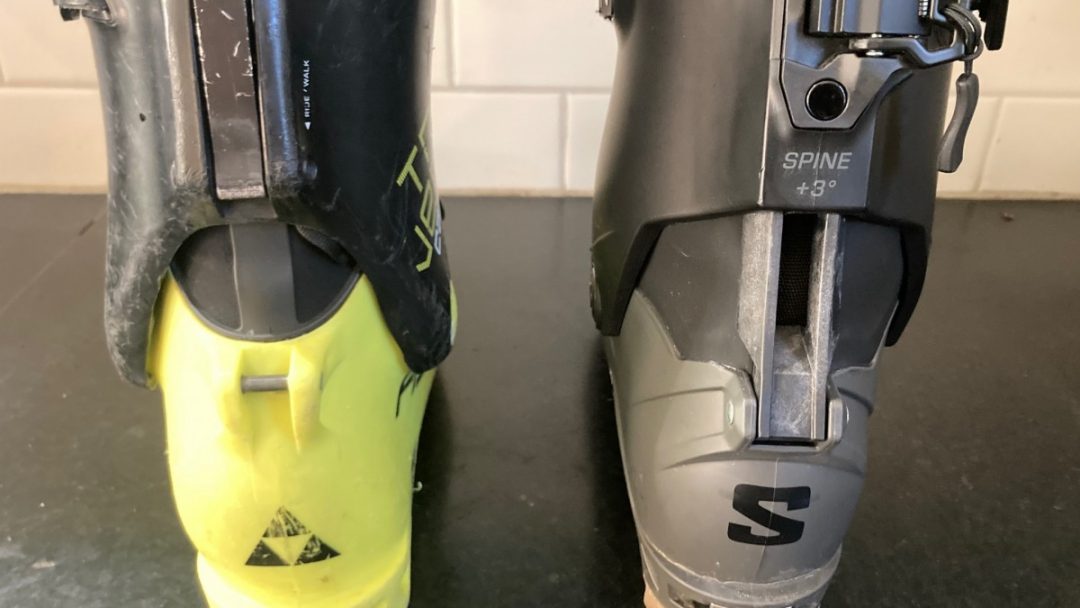
A side by side image showing two distinct takes on lock out mechanism. Of note on the S/Lab MTN Summits (right) is the rear spine sitting inside the upper cuff.
Descending:
First, a quick point of reference; for better or for worse, I pretty much skied anything and everything for years in the Travers Carbon. I most definitely hit its skiable limits with a 100mm underfoot ski in variable conditions. The Travers has a progressive flex, but the cuff bellows out where the upper cuff meets the ankle (this may be due to their age, 4+ seasons). When conditions warrant really driving the ski, they now underperform unless I’m working the Black Crow’s Mentis, which is light and 80mm underfoot.
With the caveat that boot flex ratings are a ballpark and not normalized across brands, Salomon says the S/Lab MTN Summit does not have a specific flex rating for the MTN series. However, I have heard this boot referenced as a 120 flex. As advertised, these boots ski stiff. Too stiff? Not for me. This boot delivers on the promise of a relatively light boot, with a stiffness profile punching way above what we typically think of for this boot class.
As one engages the boot while leaning forward, the question arises, is it a brick wall? It is not, and the S/Lab MTN Summit does possess a progressive flex. But I’m still in the mode of maybe rewiring the brain in a sense: I’m used to the initial feedback engaging light boots, as I begin driving them, to be markedly softer than what the S/Lab MTN Summit offers up. As noted, expect stiffer than you might think.
This past weekend, we had one of those reverse wind events, where the day’s prevailing winds run opposite the norm. In any event, I had an opportunity to find some firm and stable snow. I wanted one last chance to zero in on driving the boot forward and disprove, or prove, the “brick wall” hypothesis once and for all. Here’s what I find, if you gently initiate the forward flex in the S/Lab MTN Summit, you might be startled at how stiff the feedback is. Once I recognized I was skiing the boot as if I were in a much softer model, mainly being too timid with the initiation, I drove forward with more initial oomph. In my experience, a month into the boot, this is how skiers will realize the control potential the Salomon engineers present us.
The boot comes spec with a 13.5° forward lean. I felt too upright and flipped a bar on the rear spine to increase the forward angle; it only takes quick work with a Torx wrench to adjust the tilt to a more aggressive 16.5° tilt.
Skis used: Black Crows Mentis, and G3 FINDr 86. I still need to get the S/Lab MTN Summits driving the Backland 107s, and I think that’s possible on a soft powder day.
Bindings used: BD Helio LT, G3 Zed 9.
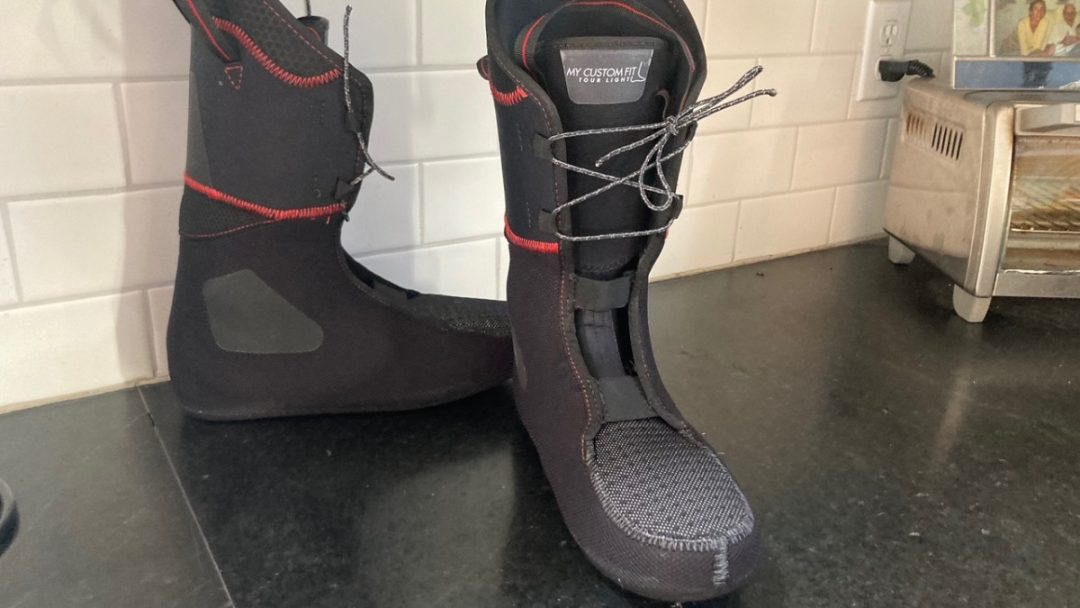
This is a robust heatmoldable liner with stiff foam in keys areas for added support.

Reinforcements on the liners help protect high wear areas on the inner/outer ankle and back cuff.
The Liner:
The liner is high-quality and worthy of remaining in the boot liner for those usually hellbent on opting for an aftermarket goody. Its evident Salomon spent considerable time designing it. A rubberized coating protects high wear areas around the inner and outer ankle and the upper rear cuff. The upper cuff’s foam is supremely stiff. And to make sliding the boot on and off easier, two generous nylon loops are sewn on the tongue and upper rear cuff, respectively. The front loop allows for simple tongue adjustments while wearing the boot. I added laces to the liner, which is likely unnecessary, but I had some extra Dyneema lace lying around, so why not.
Popping the liner in and out of the boot is easy. Like many boots in this class, the lower shell is weatherproofed with a fabric gator —sliding the liner past the gator isn’t a big deal.
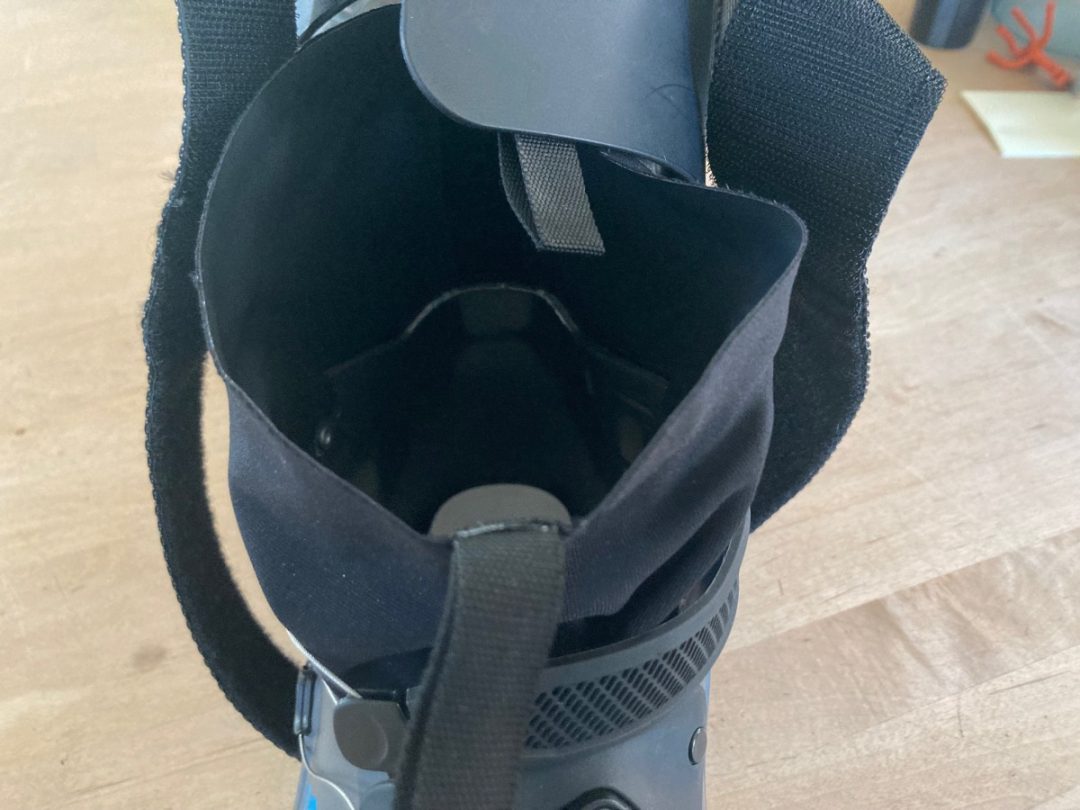
A front view of the weatherproofing on the S/Lab MTN Summit’s lower shell.

Looking down into the S/Lab MTN Summit’s shell.
Crampon Compatibility and Climbing:
I’ve used a Blue Ice Harfang with the S/Lab MTN Summit and an older model Petzl Dart. Both are fully automatic and secured to the boot well. The Harfangs were in play on a day when I sought out some easier mixed ground to settle into the boot and determine its climbing attributes. In contrast, the S/Lab MTN’s profile is somewhat beefier than the lower profile Travers Carbon. No matter, moving over rock and transitoning to snow in the S/Lab MTN Summit was smooth and unencumbered: the boot seems sensitive and mobile enough when called into climbing duty.
I then took the S/Lab MTN Summits to Hyalite Canyon in Bozeman, matching them with the mono-point Darts. Maybe I was too focused on my numbing hands, but climbing moderate water ice in these boots felt precise, comfortable, and not sketchy.
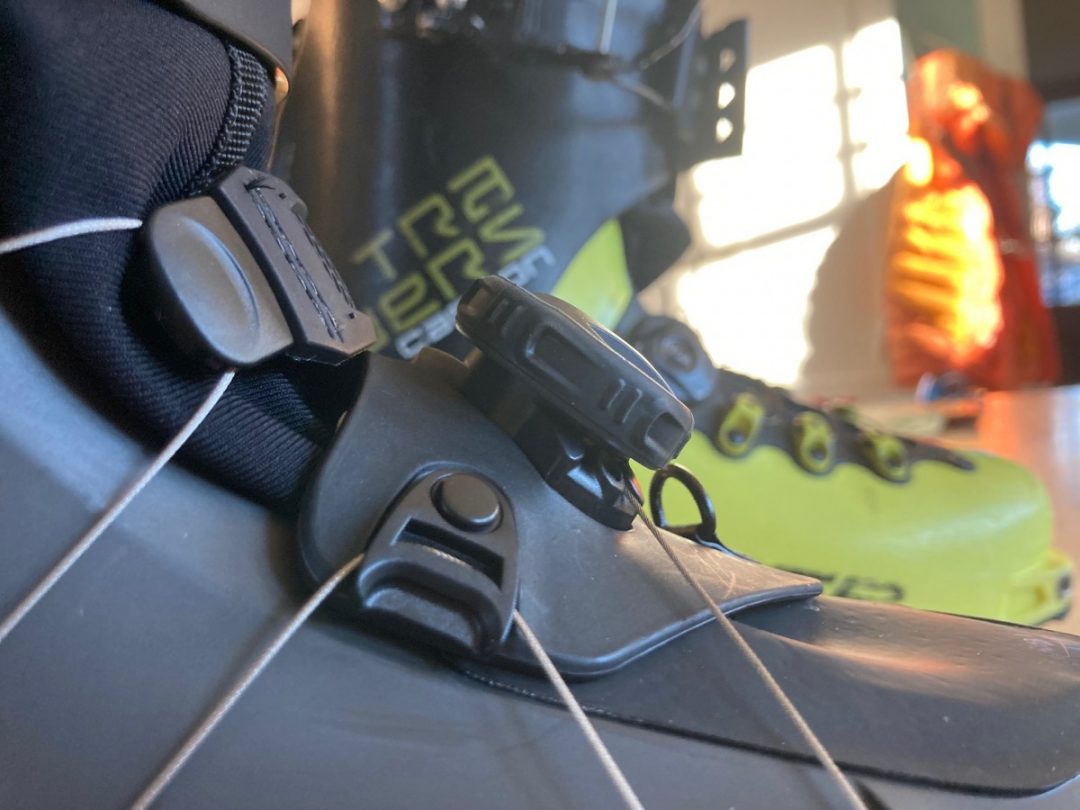
An even closer look at the S/Lab MTN Summit’s BOA knob.
There was one thing, however, semi-concerning in the back of my mind as I climbed/cramponed in the S/Lab MTN Summit, the positioning of the BOA knob. As mentioned, it lies in the middle of the instep and protrudes slightly. The Scarpa’s F1 LT’s BOA knob rests in the middle too but a bit higher up on the forefoot towards the mid-ankle. The Travers’s BOA knob is offset, towards the outside of the boot, near the lower ankle.
Over the years, I’ve replaced BOA knobs but never snapped one in the field, despite climbing Cascade choss, moderate alpine ice, and crusty booters. So far, no issues with the BOA knob placement on the S/Lab MTN Summits; this includes cramponing on a slope coated in thick rime ice, which, I thought, for sure would be the end of the BOA knob as we know it. I kicked steps—the knob still prevails.
All this BOA fixation brings to mind something I will follow up on, the ease of replacing the S/Lab MTN Summit’s BOA system in the field. The knob looks replaceable; it’s the BOA lacing I’m not too sure about—however, it seems promising.
Binding Compatibility:
The S/Lab MTN Summits are compatible with traditional tech/pin bindings, and they are not MNC certified (Salomon Shifts).
The Nitty Gritty:
The boot sole is comprised of a natural-colored rubber Salomon says is 30% reground material. To the touch, the compound is semi-soft. It’s still pretty much winter here, fingers crossed, but I’ll report back in how the sole bears a spring of volcano scrambling/skiing. To my knowledge, the rubber sole is not replaceable.
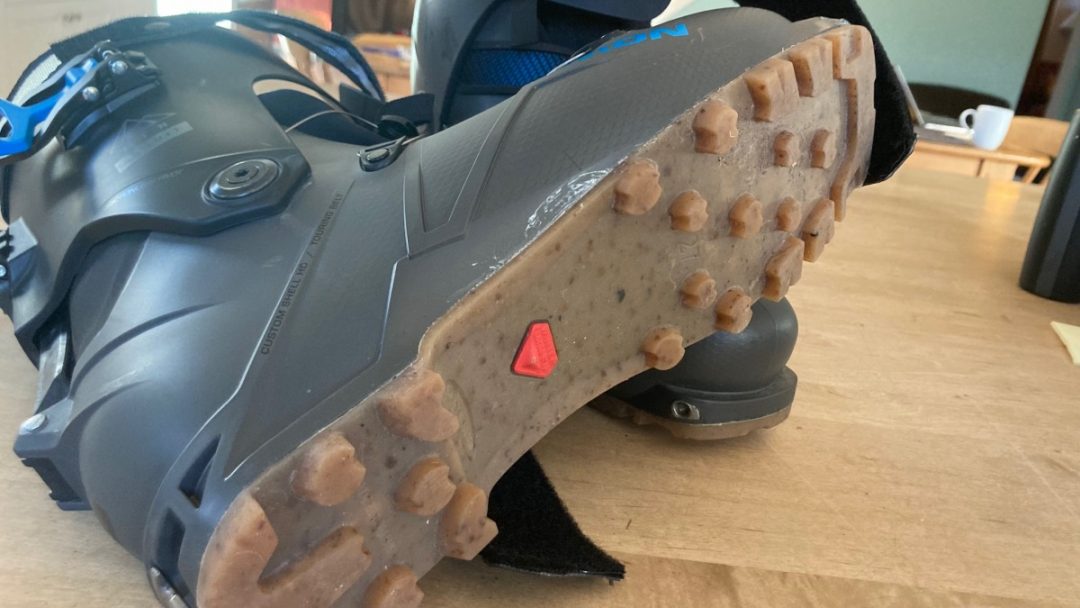
The S/Lab MTN Summit’s sole is crafted from 30% reused rubber. Durability remains something we’ll keep our eyes on.
I apologize for my tardiness to the reader who has been clicking on the site 20xs daily, awaiting this review.
There will be more shortly for those who want more beta on the S/Lab MTN Summit’s design process. Stay tuned.
Please let me know if I failed to cover something you wanted me to address. The boots should be available in Fall 2022. Or, if you are swinging through Bend and promise to be kind (and gentle to the boots because I like them) and are a 27-27.5, you are welcome to test drive this pair.
A rundown of the Specs:
Weight: approx. 1206g/boot (size 27.5)
Price: $799.00
Flex: Salomon says the boot does not have a specific flex rating. I have heard this boot’s rating referred to as a 120 flex.
Last: 100mm (size 27.5)
Salomon says 40% of the liner consists of recycled PE, the shell and cuff are 46% bio-sourced materials, the full rubber sole is 30% reground materials.
Jason Albert comes to WildSnow from Bend, Oregon. After growing up on the East Coast, he migrated from Montana to Colorado and settled in Oregon. Simple pleasures are quiet and long days touring. His gray hair might stem from his first Grand Traverse in 2000 when rented leather boots and 210cm skis were not the speed weapons he had hoped for. Jason survived the transition from free-heel kool-aid drinker to faster and lighter (think AT), and safer, are better.
